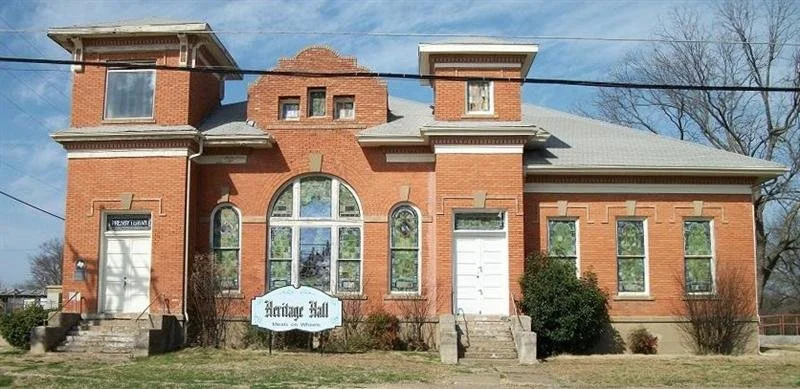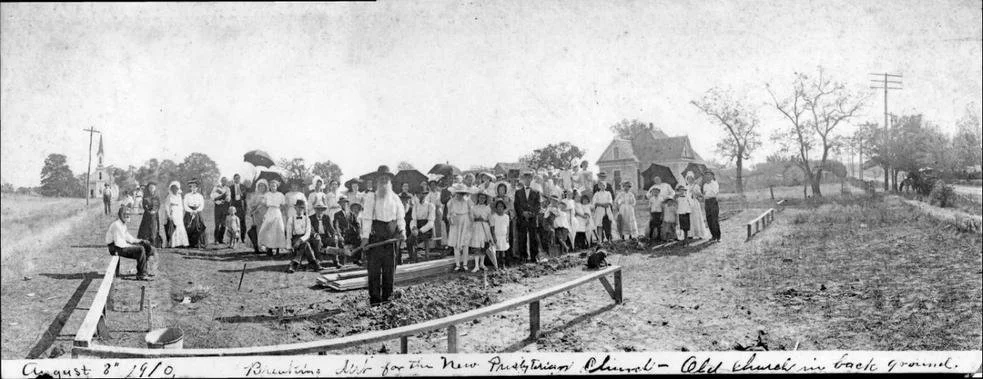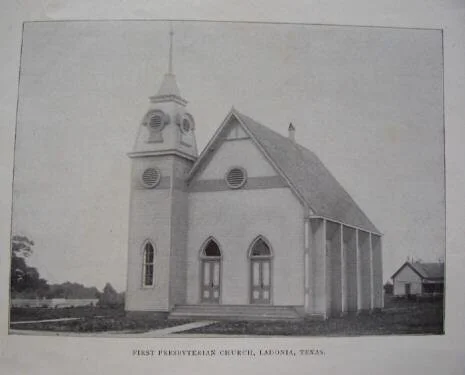Ladonia Presbyterian Church
Marker Text:
The Ladonia Presbyterian Church, U.S.A., originally organized in the mid-19th century, erected this structure between 1910 and 1912. The building contract was awarded to W. H. Markey of Commerce for $6,400. An excellent example of 20th century mission revival style adapted to an ecclesiastical mode, the structure exhibits fine detailing and proportions with the simplicity of form. The congregation was dissolved in 1976. The character defining central parapet was reconstructed in 1997.
Location: In Ladonia at Church and Paris Streets.
The following is from A History of Ladonia, Texas 1936-1997
Ladonia Presbyterian Church
by Muriel Burleson and Eunice Hill
A tract of land, a gift from John Nail and wife, for the consideration of one dollar ($1.00) was deeded to Elders Daniel S. Redner, Israel D. Maloney, and Elbert Early of the New Hope congregation of the Cumberland Presbyterian Church. The CPC was organized in the latter part of the year 1850 in the town of Ladonia, Texas.
The deed stated that the property be held in trust of the said congregation and they shall cause to be built for the use and benefit of the same church on said lot, a two-story structure, the upper story to be used for public worship and the lower story to be used for a school.
The two-story building was shared with other denominations. Professor S. D. Lowry was the first to teach in this building in 1861, and U.S.A. Presbyterian Church held its services there one Sunday each month. Beginning in the 1860's Rev. Robert Dunlap served as pastor, and remained for 25 years. At the close of the morning service he would always say, "There'll be preaching here tonight at early candle lighting".
The present brick edifice was erected from 1910-12. The building committee opened bids for the structure, and on July 18, 1910, the contract (which did not include windows, doors or stoves) was awarded to W. H. Markley, Commerce, Texas for $6,400. There were 16 3x7 stained glass windows at a cost of $75 each and two 9x14 large grouping of stained glass windows at a cost of $125 each. These windows were gifts from families active in the church, which included the Jacksons, Redners, Scotts, Wises and several others.
The outside trim is accented by a row of egg and dart pattern which measures nine inches wide and is in four foot sections of molded plaster. Horse hair is visible where it has broker. The egg and dart pattern is repeated in the 18" x 20" ceiling squares. This same trim exists on the Hunt County Museum in Greenville, Texas. Inside the sanctuary, the chair-organ area is separated from the main room by an arched panel of decorative fretwork.
The bell, which hangs in the Presbyterian, U.S.A. Church - now Heritage Hall - was bought in 1871. The women of the town and surrounding community gave musical entertainment, suppers, and bazaars to help raise money to purchase the bell. The balance was raised by public donations. The bell was hauled from Jefferson, Texas on a wagon as it was several years before Ladonia had a railroad. Thanks to Jim Crofford and Sid Davis, we now know more about the bell. From their reports, observations, and calculations, we know the bell is 24" tall, weight 2700 pounds, has a wooden sheel, 36" in diameter, is made of 3" cast iron, and has the number "36" on it.
The church placed an order for a pipe organ, costing $2,587.50. The pipe organ was originally built by Carl Barckhoff and installed in the Ladonia church in 1915. More than half of the cost ($1,500) was paid by the Carnegie Corporation of New York, which left the church with a balance of $1,087.50. The organ has been restored and is in regular use at the First Presbyterian Church in Mesquite, Texas.
In the early evening of October 7, 1992, as witnessed by Ladonians, ominous black clouds massed on the horizon near the small community of Ladonia. When the storm hit, it unleashed its fury in the form of a micro-burst - a weather phenomenon that produces winds powerful enough to pluck jetliners from the sky. When the winds abated, many of the magnificent stained glass windows were left lying in pieces, but fortunately there was no structural damage.




